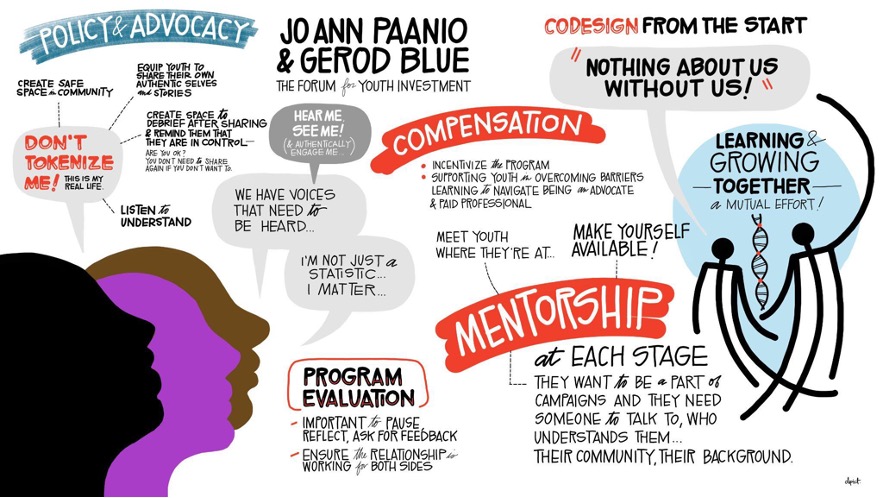
The Missing Ingredient in Policymaking and Advocacy: Young People
February 14, 2023
Young people have unique perspectives that we value.
Seema Sabnani, Chief Program Officer, Urban Alliance
There’s been an upsurge in issue-oriented advocacy campaigns led by young people in recent years, and many youth-serving organizations are beginning to tap that energy so they can ensure that new ideas and insights inform their initiatives. In campaigns like March for Our Lives, A New Deal for Youth, Advocates for Youth, and many others, young people are demanding that policymakers and leaders pay attention to their needs and those of their communities.
However, community organizations and education and workforce nonprofits have long struggled to get young people involved in their own policy and advocacy work. That left a real void in their efforts to fulfill their missions, because young people bring fresh voices, experiences, and perspectives to policy deliberations.
But things are beginning to change. Some organizations are making progress in efforts to engage youth. Notably, the 14 intermediary organizations that make up Jobs for the Future’s Building Equitable Pathways (BEP) coalition are rolling up their sleeves to find ways to authentically involve young people in the entire policymaking continuum—offering them opportunities to understand policy and political environments, co-design policy solutions that promote racial equity, and learn the details of developing and implementing communications and advocacy campaigns.
In this blog, we offer examples of effective approaches to engaging young people in policy and advocacy work. We begin with tips from leaders the Forum for Youth Investment, followed by a discussion of work underway at BEP member Urban Alliance.
Spotlight of Success
The Reconnecting Youth Campaign—an initiative that’s enlisting individuals and organizations to join forces in calling on Congress to fund 1 million pathways to education, training, national service, and employment opportunities for young people ages 16-24 who are disconnected from school and work—has successfully implemented the youth engagement tips discussed in this blog.
Adopting these approaches has helped the campaign secure increases in congressional funding for programs that support young people, including YouthBuild and youth activities authorized under Workforce Innovation and Opportunity Act.
You can learn more about the Reconnecting Youth Campaign on the organization’s website: ReconnectingYouthCampaign.org.
Five Key Tips
A Washington, DC-based nonprofit that works with national, state, and local leaders in more than 45 states on initiatives designed to improve the odds that all young people will be ready for college, work, and life by age 21, the Forum for Youth Investment is a longtime national policy partner of Jobs for the Future (JFF). The organization’s director of advocacy, Jo Ann Paanio, and its senior policy manager, Gerod Blue, recently met with representatives of BEP organizations to share strategies for getting young people involved in policy work. We offer summaries of their key tips in the graphic below, followed by more in-depth discussions of each.

Provide Training
Policymaking is complex. Effective advocacy is complex. Therefore, organizations looking to get young people involved in policymaking and advocacy efforts must equip them with the knowledge and tools that they need to succeed. That means offering training that introduces them to the policymaking process and effective approaches to advocacy. This instruction should cover the basics of how government works and how laws and policies are made, along with the advocacy tactics that are best suited to particular audiences (local, state, or federal officials, for example, or friendly groups versus skeptical ones). Training should also include activities that help learners hone their storytelling skills and offer insights that help them understand how policies impact their lives. It’s important to note, however, that training young people to be effective advocates doesn’t mean scripting their every word; it means enabling them to build the skills that allow them to speak their truth and tell stories from their own points of view.
Offer Opportunities to Co-Design Policies
The strongest policy solutions are those that are developed in an inclusive manner, with input from all stakeholders, particularly young people. Giving young people a seat at the table when you’re designing policy proposals will not only yield stronger solutions that more accurately reflect their needs; it can also give them a sense of co-ownership of the proposals, which will make them more likely to actively push to get those proposals approved—and maybe inspire them to encourage their peers to get involved in advocacy, too.
Mentor Young People—Don’t Tokenize Them
Organizations that want to engage with young people and authentically represent their needs in policy proposals or amplify their voices in advocacy campaigns should build relationships with them and work to earn their trust by providing them with a safe space and pairing them with mentors. They shouldn’t tokenize them. One way of tokenizing young people is to engage with them only to learn stories of trauma or hardships they may have endured, and then use those stories in campaigns designed to produce sympathetic responses among potential funders, partners, or policy sponsors. Tokenizing doesn’t benefit young people at all, and at worst it can reopen old wounds if they have to relive past trauma for the sake of the organization.
Pay Them
Young people should be paid for the time and effort they put into an organization’s policymaking and advocacy initiatives. As the Forum for Youth Investment says in a 2022 report titled How to Pay Young People: Considerations for Equity and Effectiveness: “We pay adults for their time, we should pay young people for the time they spend advising and sharing their expertise.” But while the idea of paying young people might seem straightforward, there are several factors organizations should consider to ensure that their approaches to youth compensation are equitable and effective and don’t jeopardize a young person’s ability to access real money. The Forum for Youth Investment report explains that factors such as immigration status or the burden of filing complex paperwork can limit a young person’s ability to access compensation in safe and practical ways. Organizations should consider accessible and alternative ways to compensate young people, but one thing they shouldn’t do is pay them with gift cards, because they tend to expire.
Ask for Feedback
Organizations engaging with youth for policy and advocacy work should periodically assess their efforts by asking the young people for feedback on their programming and engagement efforts. That feedback can help organizations make adjustments as needed to ensure that their programs continually evolve to meet young people’s ever-changing needs.
Urban Alliance: Building a Foundation for Intentional Youth Engagement
A national nonprofit building a diverse next-generation workforce by providing job skills training, mentoring, and paid internships to high-school-age youth primarily in communities of color, Urban Alliance is considering ways to engage young people in its alumni network in program design and, possibly, future policy and advocacy activities. It’s keen on getting this right, and is grappling with many of the issues discussed above.
We interviewed Urban Alliance Chief Program Officer Seema Sabnani about this work.
Why does Urban Alliance believe it’s important for young people to engage in policy making and advocacy?
Policies directly impact the young people we engage in our programming, and young people have unique perspectives that we value. If we involve more young people now in our program design and policy considerations, then we can help ensure diverse representation at the decision-making table where policies, funding, and resources are discussed. We also recognize that educating, informing, and engaging young people as early as possible can prepare them to be effective policy advocates.
What considerations are you grappling with currently when thinking about programming that connects Urban Alliance’s alumni to policy?
We are currently grappling with how to build a solid foundation for thoughtful partnership and programmatic co-production among our alumni and the young adults we engage. We believe that building a solid foundation of partnership and engagement, and hearing directly from youth about their needs and experiences with our programing is key in setting us up for success in future activities that involve working with young adults in policy and advocacy.
We are currently building a foundation of Urban Alliance youth-adult co-production through our Youth Advisory Council (YAC). The YAC’s goal is to facilitate an opportunity for our young people to provide deeper insight and more accuracy to Urban Alliance’s evaluative and programmatic work. The YAC engages young people to foster more inclusive and culturally accurate evaluative and programmatic efforts while developing their technical and interpersonal skills. As a result of their work, the evaluation team will create better measurement tools and regions will receive invaluable feedback.
We’re also mindful that there are other organizations out there that have been successful in policy engagement, and in engaging youth in program design and policy and advocacy. We don’t want to reinvent the wheel, but rather be intentional about learning from others’ success and challenges. We also rely on our mission and vision to guide us in seeking opportunities to engage in strategic partnerships with other organizations that can be leveraged for policymaking and advocacy in the future.
What would be the ideal outcomes of engaging Urban Alliance’s alumni in policy and advocacy?
We’re looking to build a policymaking infrastructure that reflects a co-production process where our alumni and the young adults we engage with decide on the issue areas we focus on and where as an intermediary we’ll continue supporting and facilitating their connection and engagement across stakeholders.
‘Power and Voice to Create Change’
As education and workforce nonprofit organizations prepare for a new year of federal and state policymaking, it’s a good time to ask this question: Are we effectively engaging young people in policymaking, and if not, how can we take steps to do so?
Young people are eager to engage in policy and advocacy work, and they’re adept at using social media tools. That means all parties involved can benefit when an organization makes a sincere effort to engage youth. The young people learn important lessons about what it takes to design and promote policies at every level of government, and the adult leaders of the organization can gain some vital insights about using social media tools and other effective new ways to engage in advocacy in the 21st century.
As a 21-year old woman who identified as Hispanic said in a focus group conducted as part of the research that yielded the findings reported in “Staying Engaged,” a 2020 Equitable Futures brief: “Clearly, the generations before us have not pushed through the change yet that we need to see in the world, so it is now up to us to do so. . . . I think that with social media we now have so much more power and voice to create change than previous generations had at our age.”


